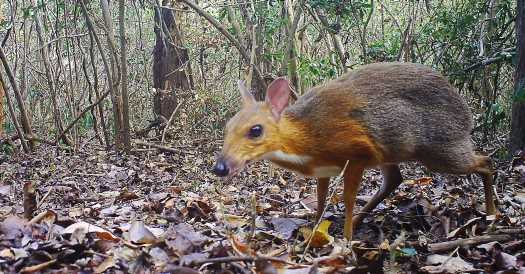The illegal wildlife trade in Vietnam has depleted some forests so drastically that scientists call the result “empty forest syndrome,” where almost nothing sings or crawls or rustles the branches.
“There’s a beautiful, vibrant tropical forest around you, but no animals in it,” said Andrew Tilker, a scientist with Global Wildlife Conservation and doctoral student at the Leibniz Institute for Zoo and Wildlife Research in Berlin. “It’s an eerie feeling.”
Within this emptiness, Mr. Tilker and a team of researchers went looking for a small, deer-like mammal called the silver-backed chevrotain, which scientists hadn’t seen any evidence of in nearly 30 years. But, the team reported Monday in Nature Ecology & Evolution, there’s at least one pocket of forest where the mammal is alive and well, for now.
With its Search for Lost Species initiative, Global Wildlife Conservation aims to highlight species, like the silver-backed chevrotain, that are “lost” to science, but not necessarily extinct. Scientists have only recorded five silver-backed chevrotain specimens. All of them were already dead. The first four appeared in 1910, and the final specimen, killed by a hunter, turned up in 1990.
Researchers had no reason to think the silver-backed chevrotain had gone extinct. But the researchers also had no idea where to find the animal.
In March 2017, members of the research team brainstormed about where to look for the silver-backed chevrotain. They focused on dry coastal forest in the southern part of Vietnam, near where the first specimens turned up more than a century earlier. It’s a very different habitat from the wet evergreen forests that are common across the country, Mr. Tilker says, but other research in those forests hadn’t turned up any silver-backed chevrotains. “We thought, hey, why don’t we go somewhere different?”
Next, Vietnamese team members interviewed local residents about whether they had seen any silver-backed chevrotains in the forest. It was a delicate question, Mr. Tilker said, because the wire-snare hunting that has emptied Vietnamese forests is illegal. Most of it supplies a thriving illegal wildlife trade, with much of the meat ending up in restaurants. Some of the people who could best answer the scientists’ questions were hunters and traders.
An Nguyen, also a Global Wildlife Conservation scientist and a Leibniz Institute doctoral student, led the interviews. Researchers started with simple questions about people’s lives to get them comfortable, Mr. Nguyen said, and then asked about wildlife in the forest. Had they seen the little deer-like animal with a pointed face, tawny fur and a grizzled back?
Everyone interviewed said that chevrotain populations (including the silver-backed as well as another species, the lesser chevrotain) had plummeted in recent years from hunting. But at least nine of the 35 people interviewed said they had seen a silver-backed chevrotain. One person walked researchers into the forest and showed scientists the exact location. The team used the information to set up camera traps, or motion-activated cameras that snap a burst of photos whenever something walks by.
A few months later, the researchers collected the cameras they had left in the forest and combed through the pictures. In photograph after photograph, there it was: the silver-backed chevrotain. It appeared in daytime, usually alone. The cameras had captured the species on 208 separate occasions.
Mr. Nguyen says that after walking through the camera trap sites and seeing footprints and other evidence of mammal life, the pictures didn’t surprise him. Still, they’re the first known photos of silver-backed chevrotains alive, and the first scientific evidence of the creature in almost three decades.
The silver-backed chevrotain is one of many species unique to the Annamite Mountains of Vietnam and Laos. Tran Van Bang, a co-author of the study and scientist with the Vietnam Academy of Science and Technology’s Southern Institute of Ecology, said that learning more about these species is important for drawing attention and resources to these threatened forests. To keep the silver-backed chevrotain safe in the immediate future, though, the authors aren’t saying exactly where they put their cameras.
But they may have said too much already, said Diana Bell, a professor of conservation biology at the University of East Anglia whose research team has also worked with elusive wildlife in Vietnam. “I think the most important point it raises is whether authors should in fact be publicizing the rediscovery of a critically endangered species.”
Even though the scientists have hidden the silver-backed chevrotain’s exact location, Dr. Bell worries that the publication could increase demand for the animal by hunters.
“It is deeply depressing that conservation biologists should now be placed in this dilemma,” she added.
Mr. Tilker agreed that hunting is the most imminent danger to species like the silver-backed chevrotain. Even if the animals remaining in the Vietnamese forests avoid extinction from hunting, they will still face other threats including climate change and habitat destruction. But knowing where some animals are still hiding out is a first step toward keeping them alive.
“Until we find the species and start learning something about it, it’s not possible to do any sort of conservation,” Mr. Tilker said. “It’s hard to protect a species if you don’t know if it still exists.”
Source: Read Full Article
